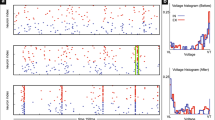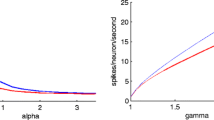Abstract
Homogeneously structured networks of neurons driven by noise can exhibit a broad range of dynamic behavior. This dynamic behavior can range from homogeneity to synchrony, and often incorporates brief spurts of collaborative activity which we call multiple-firing-events (MFEs). These multiple-firing-events depend on neither structured architecture nor structured input, and are an emergent property of the system. Although these MFEs likely play a major role in the neuronal avalanches observed in culture and in vivo, the mechanisms underlying these MFEs cannot easily be captured using current population-dynamics models. In this work we introduce a coarse-grained framework which illustrates certain dynamics responsible for the generation of MFEs. By using a new kind of ensemble-average, this coarse-grained framework can not only address the nucleation of MFEs, but can also faithfully capture a broad range of dynamic regimes ranging from homogeneity to synchrony.










Similar content being viewed by others
References
Battaglia, D., & Hansel, D. (2011). Synchronous chaos and broad band gamma rhythm in a minimal multi-layer model of primary visual cortex. PLoS Computational Biology, 7.
Beggs, J.M., & Plenz, D. (2003). Neuronal avalanches in neocortical circuits. Journal of Neuroscience, 23(35), 11167–11177.
Bornholdt, S., & Rohl, T. (2003). Self-organized critical neural networks. Physical Review E, 67, 066118.
Brunel, N. (2000). Dynamics of sparsely connected networks of excitatory and inhibitory spiking neurons. Journal of Comparative Neuroscience, 8, 183–208.
Buice, M.A., & Chow, C.C. (2007). Correlations, fluctuations, and stability of a finite-size network of coupled oscillators. Physical Review E, 76, 031118.1–031118.25.
Cai, D., Tao, L., Shelley, M., McLaughlin, D. (2004). An effective kinetic representation of fluctuation-driven neuronal networks with application to simple and complex cells in visual cortex. Proceedings of the Natural Academy Sciences, 101(20), 7757–7762.
Cai, D., Tao, L., Rangan, A., McLaughlin, D. (2006). Kinetic theory for neuronal network dynamics. Committee in Mathematical Science, 4, 97–127.
Cardanobile, S., & Rotter, S. (2010). Multiplicatively interacting point processes and applications to neural modeling. Journal of Computational Neuroscience, 28, 267–284.
Churchland, M.M., et al. (2010). Stimulus onset quenches neural variability: A widespread cortical phenomenon. Nature Neuroscience, 13(3), 369–378.
Csicsvari, J., Hirase, H., Mamiya, A., Buzsaki, G. (2000). Ensemble patterns of hippocampal ca3-ca1 neurons during sharp wave-associated population events. Neuron, 28, 585–594.
Dehghani, N., Hatsopoulos, N.G., Haga, N.G., Parker, R.A., Greger, B., Halgren, E., Cash, S.S., Destexhe, A. (2012). Avalanche analysis from multi-electrode ensemble recordings in cat, monkey and human cerebral cortex during wakefulness and sleep. arXiv:1203.0738v4:[q–bio.NC].
Erdős, P., & Rényi (1959). On random graphs. I. Publicationes Mathematiques (Debr.), 6, 290–297.
Erdős, P., & Rényi (1960). On the evolution of random graphs. Magy. Tud. Akad, Mat. Kut. Intéz. Közl., 5, 17–61.
Hahn, G., Petermann, T., Havenith, M.N., Yu, S., Singer, W., Plenz, D., Nikolic, D. (2010). Neuronal avalanches in spontaneous activity in vivo. Journal of Neurophysiology, 104, 3313–3322.
Hatsopoulos, N.G., Ojakangas, C.L., Paniniski, L., Donoghue, J.P. (1998). Information about movement direction obtained from synchronous activity of motor cortical neurons. Proceedings of the National Academy of Science, 95, 15706–15711.
Hu, Y., Trousdale, J., Josic, K., Shea-Brown, E. (2013). Motif statistics and spike correlations in neuronal networks. Journal of Statistical Mechanics, P03012, 1–51.
Kenet, T., Bibitchkov, D., Tsodyks, M., Grinvald, A., Arieli, A. (2003). Spontaneously emerging cortical representations of visual attributes. Nature, 425, 954–956.
Kohn, A., & Smith, M.A. (2005). Stimulus dependence of neuronal correlation in primary visual cortex of the macaque. Journal of Neuroscience, 25, 3661–73.
Lampl, I., Reichova, I., Ferster, D. (1999). Synchronous membrane potential fluctuations in neurons of the cat visual cortex. Neuron, 22, 361–374.
Ledoux, E., & Brunel, N. (2011). Dynamics of networks of excitatory and inhibitory neurons in response to time-dependent inputs. Frontiers in Computational Neuroscience, 5(25), 1–17.
Lee DeVille, R.E., & Peskin, C.S. (2012). Synchrony and asynchrony for neuronal dynamics defined on complex networks. Bulletin of Mathematical Biology, 74, 769–802.
Leinekugel, X., Khazipov, R., Cannon, R., Hirase, H., Ben-Ari, Y., Buzsaki, G. (2002). Correlated bursts of activity in the neonatal hippocampus in vivo. Science, 296, 2049–2052.
Mazzoni, A., Broccard, F.D., Garcia-Perez, E., Bonifazi, P., Ruaro, M.E., Torre, V. (2007). On the dynamics of the spontaneous activity in neuronal networks. PLoS One, 5, e439.
Newhall, K., Kovacic, G., Kramer, P., Zhou, D., Rangan, A.V., Cai, D. (2010). Dynamics of current-based, poisson driven, integrate-and-fire neuronal networks. Committee in Mathematical Science, 8(2), 541–600.
Ostojic, S., & Brunel, N. (2011). From spiking neuron models to linear-nonlinear models. PLoS Computational Biology, 7(1), e1001056.
Petermann, T., Thiagarajan, T.C., Lebedev, M.A., Nicolelis, M.A.L., Chailvo, D.R., Plenz, D. (2009). Spontaneous cortical activity in awake monkeys composed of neuronal avalanches. Proceedings of the National Academy of Science, 106(37), 15921–15926.
Plenz, D., Stewart, C.V., Shew, W., Yang, H., Klaus, A., Bellay, T. (2011). Multi-electrode array recordings of neuronal avalanches in organotypic cultures. Journal of Visualized Experiments, 54, 2949.
Poil, S.S., Hardstone, R., Mansvelder, H.D., Linkenkaer-Hansen, K. (2012). Critical-state dynamics of avalanches and oscillations jointly emerge from balanced excitation/inhibition in neuronal networks. Journal of Neuroscience, 33, 9817–9823.
Rangan, A.V. (2009). Diagrammatic expansion of pulse-coupled network dynamics. Physical Review Letters, 102, 158101.
Rangan, A.V., & Young, L.S. (2013a). Dynamics of spiking neurons: between homogeneity and synchrony. Journal of Computational Neuroscience. doi:10.1007/s10827-012-0429-1.
Rangan, A.V., & Young, L.S. (2013b). Emergent dynamics in a model of visual cortex. Journal of Computational Neuroscience. doi:10.1007/s10827-013-0445-9.
Rangan, A.V., & Cai, D. (2006). Maximum-entropy closures for kinetic theories of neuronal network dynamics. Physical Review Letters, 96, 178101.
Roxin, A., Brunel, N., Hansel, D., Mongillo, G., Vreeswijk, C.V. (2011). On the distribution of firing rates in networks of cortical neurons. Journal of Neuroscience, 31(45), 16217–16226.
Sakata, S., & Harris, K.D. (2009). Laminar structure of spontaneous and sensory-evoked population activity in auditory cortex. Neuron, 12(3), 404–418.
Samonds, J.M., Zhou, Z., Bernard, M.R., Bonds, A.B. (2005). Synchronous activity in cat visual cortex encodes collinear and cocircular contours. Journal of Neurophysiology, 95(4), 2602–2616.
Shew, S., Yang, H., Yu, S., Roy, R., Plenz, D. (2011). Information capacity and transmission are maximized in balanced cortical networks with neuronal avalanches. Journal of Neuroscience, 31, 55–63.
Sirovich, L., Omurtag, A., Knight, B. (2000). Dynamics of neuronal populations; the equilibrium solution. SIAM Journal on Applied Mathematics, 60, 2009–2028.
Vogels, T.P., & Abbott, L.F. (2005). Signal propagation and logic gating in networks of integrate-and-fire neurons. Journal of Neuroscience, 25, 10786–95.
Werner, G. (2007). Metastability, criticality and phase transitions in brain and its models. BioSystems, 90, 496–508.
Yu, Y., & Ferster, D. (2010). Membrane potential synchrony in primary visual cortex during sensory stimulation. Neuron, 68, 1187–1201.
Yu, S., Yang, H., Nakahara, H., Santos, G.S., Nikolic, D., Plenz, D. (2011). Higher-order interactions characterized in cortical activity. Journal of Neuroscience, 31, 17514–17526.
Zhang, J.W., Newhall, K., Zhou, D., Rangan, A.V. (2013). Distribution of correlated spiking events in a population-based approach for integrate-and-fire networks. Journal of Computational Neuroscience. 1–17. doi:10.1007/s10827-013-0472-6.
Zhao, L.Q., Beverlin, B., Netoff, T., Nykamp, D.Q. (2011). Synchronization from second order network connectivity statistics. Frontiers in Computational Neuroscience, 5(28), 1-16. doi:10.3389/fncom.2011.00028.
Acknowledgments
JZ is partially supported by NSF Grant DMS-1009575. AR is supported by NSF Grants DMS-0914827 and DMS/NIGMS-1162548. DZ is supported by Shanghai Pujiang Program (Grant No. 10PJ1406300), NSFC (Grant No. 11101275 and No. 91230202) and the Scientific Research Foundation for the Returned Overseas Chinese Scholars from State Education Ministry in China. DC is supported by NSF Grant DMS-1009575. DZ and DC are supported by New York University Abu Dhabi Research Grant G1301.
Conflict of interests
The authors declare that they have no conflict of interest.
Author information
Authors and Affiliations
Corresponding author
Additional information
Action Editor: Michael Breakspear
Electronic supplementary material
Appendices
Appendix A: Spike resolution
As mentioned in Section 3.1, the system of ODEs given by Eq. (1) is not actually well-posed. We need to clarify the dynamics that ensue whenever multiple neurons cross threshold simultaneously (e.g,. as a consequence of an excitatory synaptic event). To ensure that our system is well-posed, we consider our system to be a specific limit of the following conductance-based system:
where the \(g_{j}^{Q,R}\) model synaptic conductances, and the α E and α I are alpha-functions with infinite rise-time and decay times τ E and τ I , respectively. For this conductance-based system we also assume that, after any one neuron fires, it is held at V L for a time \(\tau _{\text {ref}}\), referred to as a refractory period. The well-posed system of ODEs that we use in this work, alluded to by Eq. (1), is actually the system given by Eq. (11) in the limit τ I , τ E , \(\tau _{\text {ref}} \rightarrow 0\), with \(\tau _{I}\ll \tau _{E}\ll \tau _{\text {ref}}\). This is equivalent to the resolution rule used in Refs. (Rangan and Young 2013a) and (Zhang et al. 2013b).The resolution rule we use affects the dynamics within each MFE. For example, if we had instead taken the limit \(\tau _{E}\ll \tau _{I}\ll \tau _{\text {ref}} \rightarrow 0\), then the inhibitory neurons would not participate during any MFE, and the dynamics of each MFE could be determined by examining only the excitatory population.
Appendix B: Choosing L ̄
In Section 4.2 we use the PEA-framework to single out MFEs which have magnitude ≥ L ̄ , where L ̄ = 2. MFEs of magnitude less than L ̄ will not be singled out for consideration, and will be lumped into the master-equation evolution of the joint-distribution. In principle, we could have chosen a different number for this ‘MFE-threshold’. When choosing L ̄ , we must balance the following two conflicting goals.
On one hand, if we would like to carefully resolve the dynamics, we should choose L ̄ to be small. Taken to the extreme, setting L ̄ = 1 ensures that we never miss any emergent transients within the network – every firing-event will be resolved and the collection of possible PEA-trajectories will correspond exactly to the ensemble Ω. The drawback to choosing a small L ̄ is that we will frequently be required to resolve synaptic-events, which may be computationally costly.
On the other hand, if we would like to efficiently coarse-grain the dynamics in preparation for dimension-reduction, we should choose L ̄ to be large. If, however, we take L ̄ to be larger than the typical MFE size, then we will miss the majority of the interesting behavior; f B will reduce to f , and the PEA-framework will reduce to the standard ensemble average.
One way in which we can balance these two goals within our implementation is to choose L ̄ adaptively. Ideally, if the system is currently in a state where l simultaneous excitatory firing-events would often lead to larger MFEs, then we would want L ̄ to be no bigger than l. Given the assumptions we make in Section Section 4.3, we can use this idea to define L ̄ (t) at each time-step by appealing to \(\boldsymbol {\rho }_{\textit {single}}(v,t)\). Given \(\boldsymbol {\rho }_{\text {single}}\) we can calculate the likelihood \(P(L_{E},L_{I}|l ; \boldsymbol {\rho }_{\text {single}}(\cdot ,t))\) that an MFE of magnitude \(L_{E},L_{I}\) would be generated, given that l excitatory neurons are driven across threshold by the Poisson input at time t and the other neurons in the network are drawn from \(\boldsymbol {\rho }_{\text {single}}(v,t)\) (Zhang et al. 2013b). We then choose L ̄ (t) to be the smallest l for which \(P(L_{E},L_{I}|l ; \boldsymbol {\rho }_{\text {single}}(\cdot ,t))\) has a substantial nonzero component for values of L Q > l. That is to say, we calculate the sums:
and choose L ̄ (t) to be the smallest l for which Z l (t) is non-negligible.Adaptively choosing L ̄ can allow us to efficiently resolve the dynamics of networks which, under drive, switch from one type of regime to another. More details on this algorithm will be reported elsewhere.
Rights and permissions
About this article
Cite this article
Zhang, J., Zhou, D., Cai, D. et al. A coarse-grained framework for spiking neuronal networks: between homogeneity and synchrony. J Comput Neurosci 37, 81–104 (2014). https://doi.org/10.1007/s10827-013-0488-y
Received:
Revised:
Accepted:
Published:
Issue Date:
DOI: https://doi.org/10.1007/s10827-013-0488-y




